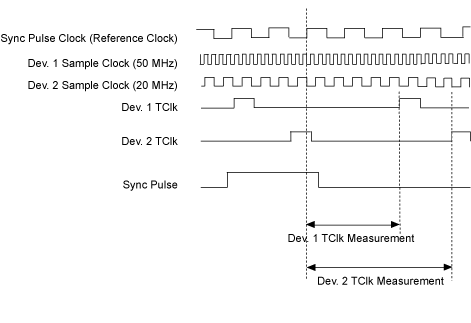NI-TClk
Sync Pulse and Sync Pulse Clock
Sync Pulse
The Sync Pulse signal is used to synchronize TClk signals on different devices. When you run the niTClk Synchronize VI or the niTClk_Synchronize function, NI-TClk causes one of the synchronized devices to produce a series of Sync Pulses, which must be received by all the synchronized devices. The Sync Pulse is used to measure the misalignment between TClks on different devices, as shown in the following figure.

If all the devices are in one PXI chassis or one PC, the niTClk Synchronize VI or the niTClk_Synchronize function routes the Sync Pulse automatically, assuming that a PXI trigger line or a RTSI line is available.
If the devices are in multiple PXI chassis, or if the devices are in a PXI chassis with multiple bus segments (18-slot chassis), the Sync Pulse signal is not automatically routed, so you must configure the signal routing for the system.
Sync Pulse Clock
Sync Pulse Clock is another signal used during the synchronization of TClk signals on different devices. For PXI devices, this signal must come from PXI_CLK10. For PCI devices, it must come from RTSI 7. Typically, the Reference Clock is used as the Sync Pulse Clock, as shown in the previous figure.
For both PXI and PCI devices, the signal must be 10 MHz. The niTClk Synchronize VI or the niTClk_Synchronize function routes this signal automatically unless you use the Sync Pulse Clock Source property or the NITCLK_ATTR_SYNC_PULSE_CLOCK_SOURCE attribute.